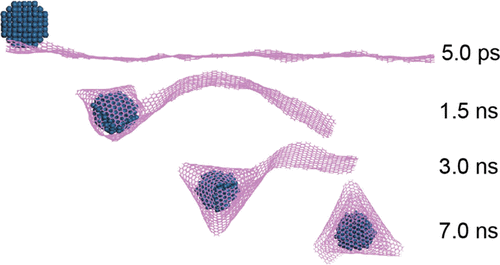当前位置:
X-MOL 学术
›
J. Phys. Chem. C
›
论文详情
Our official English website, www.x-mol.net, welcomes your
feedback! (Note: you will need to create a separate account there.)
Folding 2D Graphene Nanoribbons into 3D Nanocages Induced by Platinum Nanoclusters
The Journal of Physical Chemistry C ( IF 3.3 ) Pub Date : 2020-03-24 , DOI: 10.1021/acs.jpcc.0c00463 Jie Song 1 , Xiaomei Xia 1 , Jiatian Chen 1 , Dan Xia 1 , Qingzhong Xue 2 , Qiang Li 3 , Mingdong Dong 4
The Journal of Physical Chemistry C ( IF 3.3 ) Pub Date : 2020-03-24 , DOI: 10.1021/acs.jpcc.0c00463 Jie Song 1 , Xiaomei Xia 1 , Jiatian Chen 1 , Dan Xia 1 , Qingzhong Xue 2 , Qiang Li 3 , Mingdong Dong 4
Affiliation

|
Manipulating graphene to controllably design three-dimensional (3D) architectures of graphene would be an intriguing approach to prevent two-dimensional (2D) aggregation. Herein, 2D graphene nanoribbons (GNRs) have been controllably folded into 3D graphene nanocages (GNCs) by introducing platinum nanoclusters (Pt NCs) forming composite nanoclusters. The van der Waals interaction between the GNR and Pt NC plays a critical role in the self-folding process. The nanocluster shape influences the outer cage of the composite nanocluster largely, in which the spherical Pt NCs could initiate the formation of tetrahedron GNC or graphene nanoscroll, while the other shaped Pt NCs conduct the GNC folding contour the nanocluster geometry. In addition, the sizes of Pt NCs and GNRs also significantly influenced the self-folding process. The controlled folding of 2D GNRs into 3D architectures opens up new avenues for the exploration and fabrication of unique graphene-based nanomaterials and nanodevices toward energy and drug delivery applications.
中文翻译:

将2D石墨烯纳米带折叠到铂纳米簇诱导的3D纳米笼中
操纵石墨烯以可控制地设计石墨烯的三维(3D)架构将是防止二维(2D)聚合的一种有趣方法。本文中,通过引入铂纳米团簇(Pt NCs)形成复合纳米团簇,可控地将2D石墨烯纳米带(GNR)折叠成3D石墨烯纳米笼(GNC)。GNR和Pt NC之间的范德华相互作用在自折叠过程中起关键作用。纳米团簇的形状在很大程度上影响了复合纳米团簇的外部笼形结构,其中球形Pt NCs可以引发四面体GNC或石墨烯纳米卷的形成,而其他形状的Pt NCs则通过GNC折叠轮廓实现了纳米团簇的几何形状。另外,Pt NCs和GNRs的大小也显着影响自折叠过程。
更新日期:2020-03-24
中文翻译:

将2D石墨烯纳米带折叠到铂纳米簇诱导的3D纳米笼中
操纵石墨烯以可控制地设计石墨烯的三维(3D)架构将是防止二维(2D)聚合的一种有趣方法。本文中,通过引入铂纳米团簇(Pt NCs)形成复合纳米团簇,可控地将2D石墨烯纳米带(GNR)折叠成3D石墨烯纳米笼(GNC)。GNR和Pt NC之间的范德华相互作用在自折叠过程中起关键作用。纳米团簇的形状在很大程度上影响了复合纳米团簇的外部笼形结构,其中球形Pt NCs可以引发四面体GNC或石墨烯纳米卷的形成,而其他形状的Pt NCs则通过GNC折叠轮廓实现了纳米团簇的几何形状。另外,Pt NCs和GNRs的大小也显着影响自折叠过程。











































 京公网安备 11010802027423号
京公网安备 11010802027423号